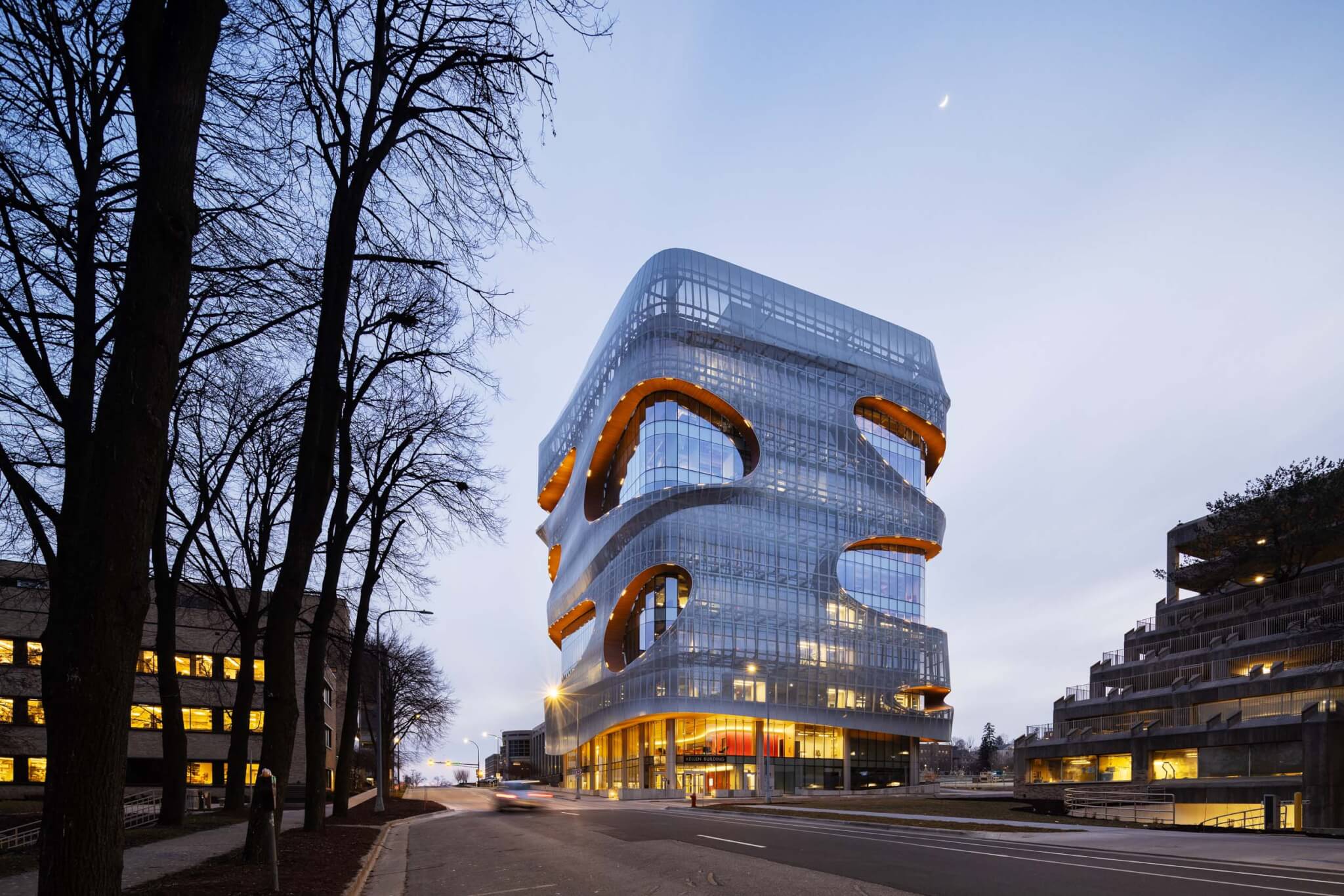- Design architect:
- HDR
- Location:
- Rochester, Minnesota
- Completion Date:
- 2024
The Mayo Clinic may be one of the most trusted names in Google searches for symptoms late at night. But the Mayo Clinic’s leadership in the realm of health sciences research is now on full display IRL with a new building designed by HDR in Rochester, Minnesota. The building is striking and stands out as a jewel on the research campus: Wrapped in a highly custom double-layered facade punctuated by “oculi” windows, the new research facility puts the Mayo Clinic’s translational research goals into action.
“The intention of the oculi is to put research on display,” said Scott Elofson, design principal at HDR. “Letting light in as well as out means the perforated metal panel ‘scrim’ is virtually transparent, inviting you in.”
Indeed this scrim on the dynamic facade is a defining element of the new building, and represents a high-tech trend in facade making across the country. These mesh-like pieces allow a facade to appear porous while also allowing for increased privacy and energy efficiency than would be allowed with more outmoded floor-to-ceiling glazing systems. But moreover, the visual interest of the scrim makes the building a standout in the landscape, a product of collaborative and creative design processes at HDR.
Elofson told AN that “The scrim is made up of custom laser cut aluminum sheets with a Kynar finish, so no two are the same.” Aluminum was the natural choice for this facade due to its weather resistance and coating performance, as well as cost.
This project is sited in the upper Midwest, where ice and snow are a prime concern for architects and designers. The design team took care to model and predict how the building’s form, and its parametric facade, would stand up to the elements over time. Greg Ramseth, associate principal at HDR, explained that “The strategy that was selected is actually fairly common, which is to have ice cleats on the sloping surfaces. We did desktop modeling for ice and snow build-up, as well as water-flume tunnel analysis for drifting snow, and the conclusion was that managing the accumulated snow rather than changing the shapes and slopes to try to avoid it was the best solution.”
Yet HDR’s exterior considerations went beyond the environmental concerns and also addressed the labor conditions it necessitated for maintenance and cleaning crews. How does one wash the windows embedded within a scrim facade? And how is that aluminum maintained over a period of years, decades? To address these, HDR asked the Mayo Clinic laborers tasked with the upkeep.

“We invited the window washers who would be maintaining the building to several charrettes to work through all of the options for window washing and facade maintenance, including a combination of ground-based lifts, swing-stages, and catwalks,” said Ramseth. “In the end, nothing was able to beat the simplicity and safety of providing access directly to the facade offered by descending on a bosun’s chair through a series of hatches that are horizontally spaced according to the reach-range of average window washer.”
The combination of oculi glazing, a dynamic scrim facade, as well as a tiered layout system of the workspaces behind the facade all contributed to the building’s final form. Of particular importance was the internal organization that HDR describes as a “risk-based zoning concept.” The research center spaces are all categorized as either Wet, Damp, or Dry spaces—and these correspond to the level of safety required by the architecture containing the research work. For example, a Wet Zone is characterized by higher chemical use, or areas where biological hazards are present.

“Careful planning of these zones with service elevators can minimize the paths of chemicals and chemical waste in the laboratory both reducing hazards and the need for his air change rates,” Ramseth offered. Damp Zones are therefore transitional spaces, like open labs for “medium-intensity” work with less stringent containment requirements, and Dry Zones are those workstations exclusivity for analytical, computational, or purely rejuvenating and relaxing activities during the workday.

(Courtesy HDR)
All of HDR’s design schemes and iterations shared the same goal: “Signaling the Mayo Clinic’s commitment to and place in the future of research,” Ramseth added. Equity in research space was top priority, and consistency in lab floors was seen as a key to the future of theme- and team-based science. The facade is more than a showpiece: It works hard to unite the security and safety priorities of scientists and researchers, while also creating a responsive and beautiful place to work and comfortably collaborate. Ramseth sums up the design intent affirming that “the solution which emerged as the best balance of all of the priorities—both innovative and familiar.”
Project Specifications
-
- Design architect: HDR
- Architect of record: HDR
- Landscape architect: WSB
- Interior design: HDR
- Structural engineering: MBJ
- Electrical engineering: HDR
- Civil engineering: WSB
- Lighting design: HDR
- AV/Acoustics: AV (Mayo Clinic) Acoustics (ESI)
- Signage/wayfinding: Mayo Clinic
- Telecommunications: HDR / Mayo Clinic
- Fire & life safety consultant: HDR
- Facade consultant: Morrison Hershfield (design); Lerch Bates (owner)
- General contractor: Knutson Construction Services
- Glazing contractor: MG McGrath
- Facade installer: MG McGrath

